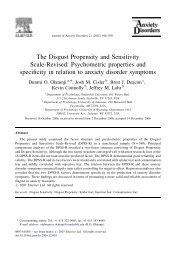introduced the Health Anxiety Inventory - University of Wyoming ...
introduced the Health Anxiety Inventory - University of Wyoming ...
introduced the Health Anxiety Inventory - University of Wyoming ...
You also want an ePaper? Increase the reach of your titles
YUMPU automatically turns print PDFs into web optimized ePapers that Google loves.
92 abramowitz et al.BAI, ASI-R, and BVS failed to demonstratediagnostic utility (range in AUC=.32–.42).DiscussionClinical observations suggest that health anxiety ispresent in a variety <strong>of</strong> psychological disorders, yetvery little empirical research on health anxietyexists in <strong>the</strong> literature. One reason for this dearth <strong>of</strong>research is that very few measures have beendeveloped to assess <strong>the</strong> construct <strong>of</strong> health anxiety.The SHAI is a novel instrument that assesses <strong>the</strong>cognitive and behavioral features <strong>of</strong> health anxiety.It possesses good psychometric properties amongindividuals with HC and among nonclinicals. Thepresent study, however, is <strong>the</strong> first to evaluate thismeasure in an anxiety disorder patient sample. It isalso <strong>the</strong> first study to empirically consider <strong>the</strong> role<strong>of</strong> health anxiety in <strong>the</strong> anxiety disorders. Giventhat <strong>the</strong> innate function <strong>of</strong> anxiety is to protect <strong>the</strong>organism against injury and harm, it is no surprisethat health concerns emerge as prominent foci <strong>of</strong>fear and worry across a number <strong>of</strong> <strong>the</strong>se conditions.The results <strong>of</strong> <strong>the</strong> present study can <strong>the</strong>reforeinform <strong>the</strong> conceptualization and treatment <strong>of</strong>clinical anxiety.Confirmatory factor analyses provided equivalentsupport for two- and three-factor models <strong>of</strong> <strong>the</strong>SHAI reported in previous studies by Salkovskis etal. (2002) and Abramowitz et al. (in press). On <strong>the</strong>basis <strong>of</strong> parsimony, we elected to examine <strong>the</strong> tw<strong>of</strong>actormodel originally reported by Salkovskis et al.(2002) assessing (a) <strong>the</strong> perceived likelihood <strong>of</strong>acquiring a serious illness, intrusive thoughts, andbody vigilance (Illness Likelihood) and (b) catastrophicbeliefs about <strong>the</strong> anticipated burden <strong>of</strong>having a serious illness (Negative Consequences).Our analyses revealed satisfactory convergent anddivergent validity for <strong>the</strong> total SHAI and <strong>the</strong> tw<strong>of</strong>actors. Specifically, <strong>the</strong> total score and IllnessLikelihood factor were moderately to stronglyassociated with <strong>the</strong>oretically overlapping constructs(i.e., body vigilance, fear <strong>of</strong> cardiovascular andrespiratory symptoms, worry) and weakly relatedto constructs considered <strong>the</strong>oretically distinct fromhealth anxiety (i.e., social anxiety, obsessive-compulsivesymptoms, and fear <strong>of</strong> cognitive dyscontrol). TheNegative Consequences factor demonstrated significantrelationships (weak to moderate in magnitude)with fears <strong>of</strong> cardiovascular symptoms and worry.These results indicate that <strong>the</strong> SHAI possesses goodreliability and validity in a clinical sample.The findings from our regression highlight <strong>the</strong>triumvirate <strong>of</strong> anxiety sensitivity, body vigilance,and worry as integral to health anxiety and HC.This is consistent with cognitive-behavioral models<strong>of</strong> HC which posit that intense health anxiety arisesas a result <strong>of</strong> <strong>the</strong> tendency to catastrophicallymisinterpret harmless bodily sensations as threatening.As a result <strong>of</strong> putting oneself on a heightenedstate <strong>of</strong> alert for signs <strong>of</strong> <strong>the</strong> feared illness, <strong>the</strong>individual becomes body vigilant. Such increasedattentional focus on internal sensations raises <strong>the</strong>individual’s awareness <strong>of</strong> normal bodily perturbations(body “noise”; e.g., ordinary fluctuations ingastrointestinal sensations, vestibular functioning,and so on), initiating a self-sustaining vicious cycle<strong>of</strong> catastrophic misinterpretation→anxiety→bodyvigilance→notice internal sensations, and so on.This has <strong>the</strong> long-term effect <strong>of</strong> streng<strong>the</strong>ning <strong>the</strong>illness worry, which might be compounded bycatastrophic thinking and an intolerance <strong>of</strong> uncertaintyregarding <strong>the</strong> negative consequences <strong>of</strong> beingill (e.g., Langlois & Ladouceur, 2004).The second aim <strong>of</strong> <strong>the</strong> present study was toexamine <strong>the</strong> role <strong>of</strong> health anxiety in <strong>the</strong> psychopathology<strong>of</strong> anxiety disorders. Consistent withconceptualizations <strong>of</strong> HC as severe health anxiety(e.g., Taylor & Asmundson, 2004), patients withthis disorder reported higher SHAI total scoresrelative to those with anxiety disorders. The findingthat PD patients evidenced higher SHAI total scoresrelative to patients with o<strong>the</strong>r anxiety disorders isalso consistent with formulations <strong>of</strong> PD as involvinghealth anxiety (Schmidt et al., 2003). Although wefound that patients with OCD did not show elevatedSHAI total scores, OCD patients did not differsignificantly from PD and HC patients in <strong>the</strong>irbeliefs about <strong>the</strong> probability <strong>of</strong> becoming ill. This isconsistent with clinical and research observationsthat, like <strong>the</strong> concerns <strong>of</strong> patients with HC and PD,obsessional preoccupation in OCD <strong>of</strong>ten focuses onhealth and illness (Abramowitz et al., 1999). Incontrast, patients with HC demonstrated elevatedbeliefs regarding <strong>the</strong> negative consequences <strong>of</strong> illhealth relative to all <strong>of</strong> <strong>the</strong> o<strong>the</strong>r patient groups. Thispattern <strong>of</strong> results suggests that whereas HC, PD, andOCD all involve preoccupation with body sensationsand <strong>the</strong> probability <strong>of</strong> becoming ill, HC (morethan <strong>the</strong>se o<strong>the</strong>r disorders) involves catastrophicbeliefs about <strong>the</strong> consequences <strong>of</strong> acquiring <strong>the</strong>feared illness.These findings have direct relevance to <strong>the</strong>assessment and treatment <strong>of</strong> HC and anxietydisorders using cognitive-behavioral <strong>the</strong>rapy. Inparticular, treatment providers should includeassessments <strong>of</strong> health-focused anxiety when workingwith anxious patients, and consider <strong>the</strong> role <strong>of</strong>such concerns as antecedents <strong>of</strong> avoidance andsafety-seeking behavior. Moreover, within <strong>the</strong> framework<strong>of</strong> available treatment manuals, cognitive<strong>the</strong>rapy techniques can be incorporated to addressAuthor's personal copy




